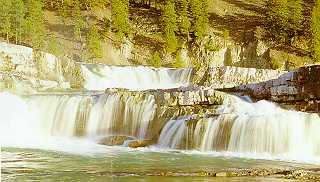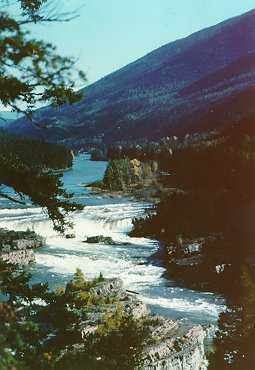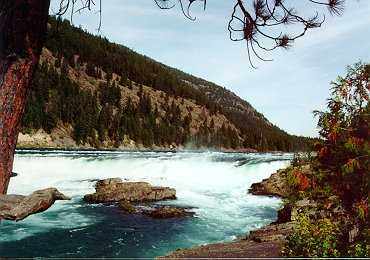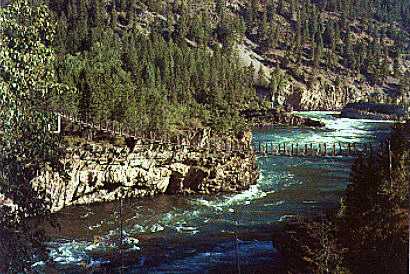Kootenai Falls
To the Kootenai Tribe, the Falls is a sacred site - the center of the world, a place where tribal members can commune with spiritual forces. Long before it can be seen, it is heard. Tons of bright green water crash over rocks as the Kootenai River loses 300 feet in elevation traveling a few hundred yards down river.

The Kootenai Indians moved into the area in the 1500s, according to historians. They were originally called the Ksunka meaning "People of the standing arrow." To the Native Americans the standing arrow represented strength, unity and dexterity. However, when the French encountered the Ksunka, they referred to them as the Kootenai, meaning "water people." The source of the word has puzzled people for many years. It is thought to be an Algonquin word. The Kootenai or Kutenai or Kootenaha came to be known as "flat bow" or "flat bow people."
Other sources say the word Kootenai means "deer robes" alluding to the natives as excellent deer hunters and tanners. The word Yaak is the Kootenai word for bow and was the Native American word for the Kootenai River while the Yaak River was called the Aak, meaning "arrow" by the early local residents. A glance at any map of the area shows today's Yaak River poised as a nocked arrow to the Kootenai River's bow. To the Kootenai tribe, the falls is a sacred site. They view it as the center of the world, a place where tribal members can commune with the spiritual forces that give direction to the tribe and to individual members.
 The falls area is a place where the Kootenai go for visions or meditation. Archaeological evidence shows the Kootenai had Native American sweat lodges and encampments up and down he river valley from Pipe Creek - where light clay was found for pipes - to the falls area. The Kootenai Tribe continues to view the falls as sacred. In 1993, Universal Studios had to negotiate with the tribe to secure permission to film "The River Wild" at the falls. Native American concerns included environmental degradation and excessive publicity leading to desecration of the sacred site. David Thompson, a Canadian explorer and employee of the Northwest Company, is considered the first white man into the Kootenai Country. In 1808 Thompson used the Kootenai River as a highway through the area following the well-trod path of the Native Americans. He portaged around the falls, following cairns - piles of rocks marking the trail - built by the Kootenais.
The falls area is a place where the Kootenai go for visions or meditation. Archaeological evidence shows the Kootenai had Native American sweat lodges and encampments up and down he river valley from Pipe Creek - where light clay was found for pipes - to the falls area. The Kootenai Tribe continues to view the falls as sacred. In 1993, Universal Studios had to negotiate with the tribe to secure permission to film "The River Wild" at the falls. Native American concerns included environmental degradation and excessive publicity leading to desecration of the sacred site. David Thompson, a Canadian explorer and employee of the Northwest Company, is considered the first white man into the Kootenai Country. In 1808 Thompson used the Kootenai River as a highway through the area following the well-trod path of the Native Americans. He portaged around the falls, following cairns - piles of rocks marking the trail - built by the Kootenais.

The rock cairns were constructed to ensure that the builder would stay "in the good graces of the many spirits which inhabited the land." A member of the Kootenai Tribe said the cairns may have been built to give good luck to travelers who took the risky portage route. Offerings to the traveler's guardian spirit would be placed on the cairn to "insure the success of one's journey." Thompson was called Kookoosint by the Native Americans. It means "man who looks at stars." He traveled with an array of surveying instruments and a telescope. The power of the river and the danger of the portage was not lost on the famous explorer. He wrote in his diary: "The River had steep banks of rocks and only 30 yards in width; this space was full of violent eddies, which threatened us with destruction; at wherever the river contracted, the case was always the same, the current was swift; yet to look at the surface, the eddies make it appear to move as much backward as forward." Thompson also wrote that he traded with two canoe loads of Indians in the area for "12 singed muskrats and a shoulder of antelope" providing him and Finan McDonald with something other than moss bread and dried carp to eat.

Today visitors stop for a respite from the travels on U.S. Highway 2 at the county park above the falls. Picnic and restroom facilities greet the traveler. Adventurous visitors enjoy the walk across the swinging bridge above the gorge. A thin walking trail leads through the dark forest and quickly down to the river, to the falls - a step back to another time.